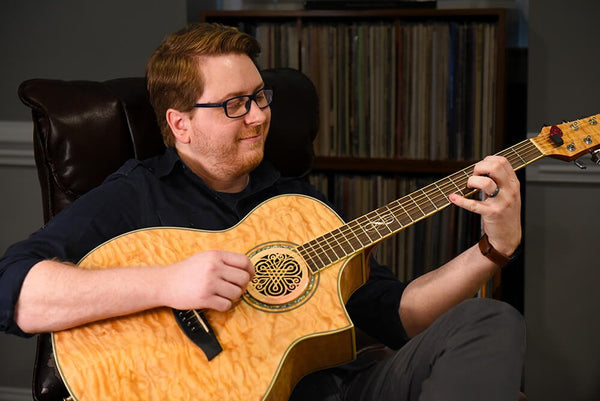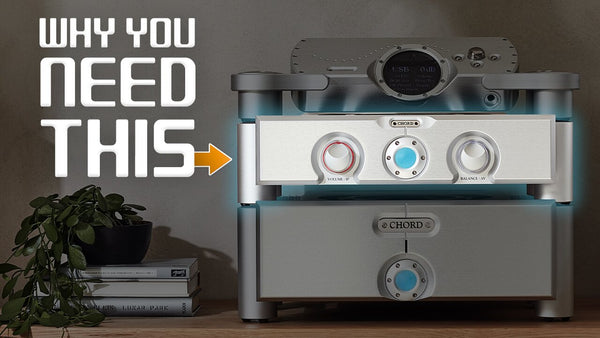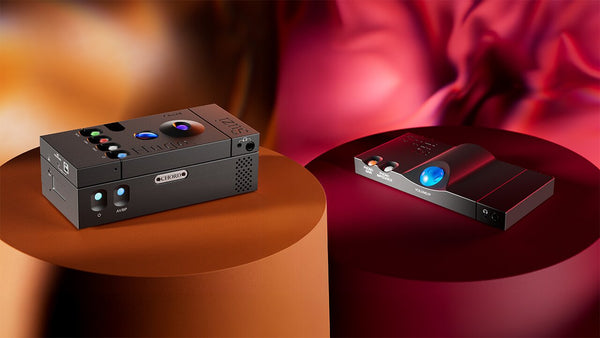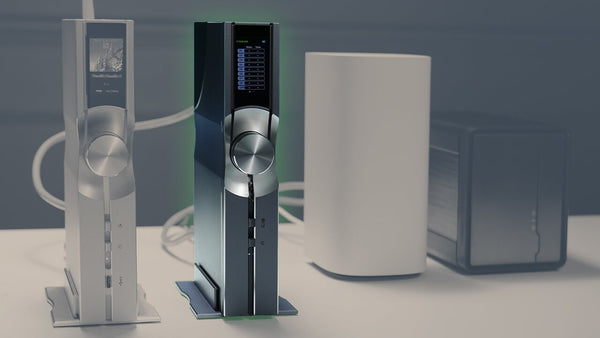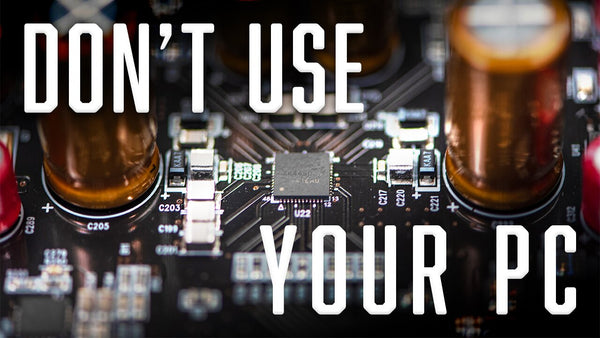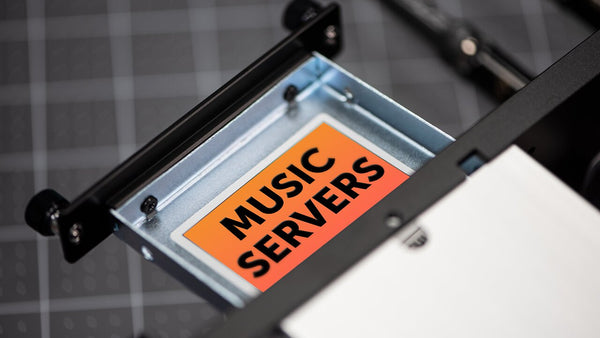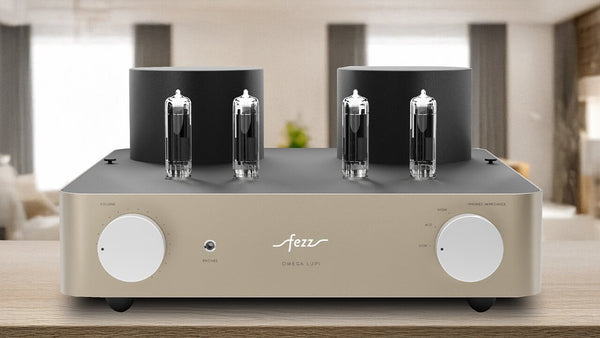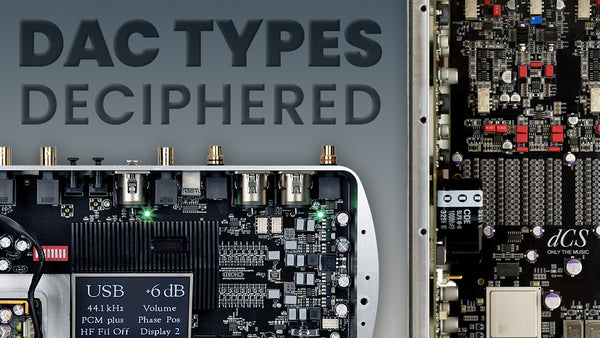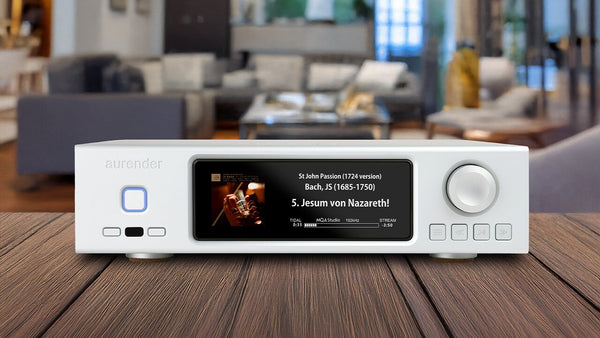Music Streaming 101: From Beginner to Audiophile
Read Time: Approx. 20 min.

Getting Your Music From Point A to Point B
Music streaming is all the rage these days, and chances are, you already do it. But are you getting the most out of your streaming music? That's the question we are here to answer today. We're also going to answer a few other questions about music streaming because everyone does it a little differently - and that's a good thing. We all like different kinds of music, we have different ergonomic scenarios, different budgets, different hearing, etc. But I think we can all agree that there's always room for improvement, and if you want the very best for your music and your ears then right now might be the best time to see if you're doing just that.
So let’s take a deeper look into not only figuring out what music streaming is but also the plethora of ways to get your music sounding the best it can be by streaming it from anywhere and any way you want.
Music Streaming 101: Understanding the Basics
Music Streaming 102: DAPs, Music Players, Portable Audiophile Gear
Music Streaming 103: Beginner's Guide to Listening at Home

PROS
- Clean setup with little to no cables
- Great sound quality
- Remote access via phone
- Connection with other devices for a complete home multi-room solution
CONS
- Wholly dependent on network connection speeds
- Can be finicky with multiple access points
- Sound quality can vary based on connection
What Is Music Streaming?
So, what is streaming? Streaming refers to any media content – live or recorded – delivered to computers, mobile devices, and more via the internet and played back in real-time. Podcasts, webcasts, movies, TV shows, and music videos are common forms of streaming content. It’s the technology of transmitting audio and/or video files in a continuous flow over a wired or wireless internet connection. This can be on a cellular device like a phone or via a computer or tablet on a home network. It can be wireless or wired. There can be just a singular device involved or multiple devices. It can be streaming via a service you pay for or it can be data you personally downloaded and own.
How does streaming work? There are 2 ways to look at this: paid services or media that you personally own. The media files are transmitted in sequential packets of data so they can be streamed instantaneously. And unlike traditional downloads that are stored on your device, media files are automatically deleted once you play them. That is if it is a streaming service like Spotify for example. But if you own the files or you are doing what is called Offline Content downloading, then in this case it is not deleted after use. All you need to stream is a reliable and fast high-speed internet connection, access or subscription to a streaming service or app, and a compatible device.
What are some examples of paid Streaming services? Spotify, Netflix, Prime Video, Qobuz, and more. This is only scratching the surface of streaming services. What are some examples of free Streaming options? Well, the biggest could be Youtube. But you could also consider the CD library you ripped and placed on a NAS on your home network - you can access it both at home and abroad and that can also be considered a streaming source.
The thing that makes it so complicated is that technically there is no right or wrong way to stream, and there are a million ways to do it. For the instances of this series, from here on out we’ll be talking about music streaming only unless otherwise clarified. Compatibility with gear is something we’ll talk about more in the last question because certain streaming services play nicer with certain gear.
But, streaming isn’t that cut and dry. Streaming could refer to connecting an external hard drive to a server, which is then used to stream the music to a set of connecting speakers or headphones. Streaming could refer to simply using wireless headphones with your phone and playing music from the phone - by “streaming” the music to the headphones, rather than from a music service. There are a lot of nuances you have to pay attention to when using the term, so be sure to pay attention to those things whenever it comes up. So from that point of view, streaming is done anytime there is a wireless connection made in your system, since the data or audio is transmitted, or streamed, to another device to help complete the signal from source to receiver.
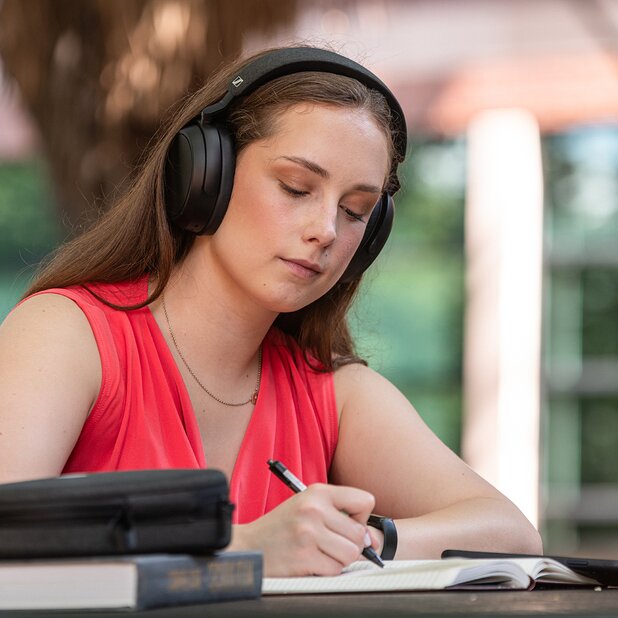
Streaming could simply refer to the application you’re using to listen to music. As we spoke about before, if you do not physically have the data or files on your source device, like your phone or computer, then you will receive those files via a wireless connection, thus resulting in being able to listen to music that is not stored on your device. The application, therefore, serves as the medium for streaming music. Spotify, Pandora, Internet Radio, Qobuz, Tidal, Deezer, SoundCloud, SiriusXM, Amazon, and Apple Music - there are tons of options out there, and we’ll get into more details later when we talk about where you can stream music.
But for the sake of this guide, to keep it simple, music streaming refers to a variety of ways to get your music from point A to point B, whatever they may be. Bottom line is that you don't have that music locally on the receiving end - whether it be a set of speakers, wireless headphones, your phone, or whatever. If you’re playing music on something where you don’t have the music stored locally, then you are effectively transmitting it, or streaming it, from elsewhere.
Streaming refers to any media content–live or recorded–delivered to computers, mobile devices, and more via the internet and played back in real-time. It's the technology of transmitting audio and/or video files in a continuous flow over a wired or wireless internet connection.
Music Streaming Decoded
Why Stream Music?
Let’s face it, storage space on portable devices like phones isn’t cheap. If you’re into high-resolution audio, then each song takes up that much more space due to more data being in the file. More data per file means less music you can store locally. The easiest way to fix this is to not worry about storage at all and just stream your favorite music via the plethora of streaming services available out there. Not all streaming services are created equal, but we’ll get to that in a bit. Many services not only have access to thousands of albums, but some offer varying degrees of resolution, which should pique the interest of audiophiles and music enthusiasts. Not every streaming service offers high-resolution music, but we have the lowdown on what each service offers in our Digital Music Guide which we’ll link to below.
High-resolution audio is only a recent thing too - due to the fact that internet and cellular speeds and data transmission could only recently efficiently send high-volume data to your device. This is good news all around, as it gets us away from lossy, compressed MP3s and provides closer, more accurate representations of the music we know and love.
Know that no two streaming services are the same, so we break it down to help you figure out the right one for you. Like Netflix, Hulu, HBO, Prime Video, Tubi, and Pluto (video streaming services) - you have choices, and depending on your preferences and what you are looking for in your music and streaming preferences, what gear you are using, and compatibility, some will be better than others for your usage case. This leads us to our next question…
The music industry has changed drastically over the past couple of decades, and physical media libraries are going by the wayside. Not entirely, mind you, but there are two things that music streaming provides that physical media cannot: Convenience and accessibility to a humongous library of thousands upon thousands of songs and albums readily available at the tap of the finger.
Where Do I Stream Music?
So if we’re talking about playing music from a source that is not directly connected to our receiver, then your music can be streamed from a number of different places (and services for that matter). The first answer is music streaming platform. For a monthly subscription, you can access thousands of songs and albums on your phone, tablet, computer, and more. It's easy, it's convenient, and it's affordable. Your typical services include Spotify, Pandora, Amazon, and Apple Music, also a host of others that offer true high-resolution files like Tidal and Qobuz which we’re big fans of here at Moon Audio. There are a ton of options to choose from, and setup is as simple as downloading the app on your phone and pressing play.
The good news is that there are lots of choices when it comes to music streaming services. We’ll go over some of the more popular streaming services here:
- Amazon Music
- Apple Music
- Pandora
- Qobuz
- Soundcloud
- Spotify
- Tidal
- YouTube Music
Amazon Music
Amazon Music Unlimited
Apple Music
Pandora
Qobuz
Soundcloud
Spotify
Tidal
YouTube
What Are the Best Music Streaming Services?
Needless to say, this is only a fraction of the total number of streaming services available right now. Each service offers its own selection of price points, libraries, and other features, so you'll need to consider which one is best for you. As you can see below, there are plenty of streaming services to choose from:
- 8tracks
- AccuRadio
- Amazon Music
- Anghami
- Apple Music
- Bandcamp
- Deezer
- Earbits
- Google Play Music
- Hoopla
- iHeartRadio
- Jango
- Joox
- Line Music
- MOOV
- Music Choice
- MyTuner Radio
- Napster
- NetEase Cloud Music
- Pandora
- Patari.pk
- Qobuz
- Radical.fm
- Saavn
- SiriusXM
- Slacker
- SoundCloud
- Spotify
- Stingray Music
- Tidal
- TuneIn
- Youtube Music
The next option is using a standalone device like a music streamer. Crazy right? Where can I stream music? Hey - try a music streamer. Thanks for coming to our Ted talk. Just kidding, but seriously - Music streamers are essentially the next step in music streaming from just playing songs off of your phone. They come in portable and desktop varieties and offer a much better music-listening experience due to their high-end components and internals. DACs, amps, and higher-processing power result in some quality high-resolution and streaming playback and is by far the preferred method of streaming for those who want to maintain a high level of sound reproduction. There are a variety of sizes, prices, features, and more, and we’ll go into more detail about specific gear, what they do and how they work in our next section.
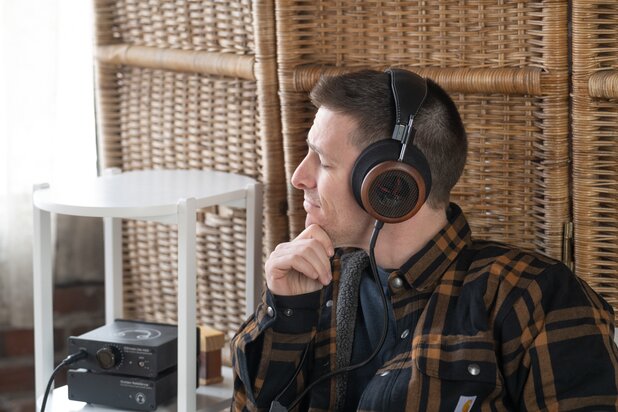
Well, what if you don’t want to pay a monthly subscription to a streaming service but you have a ton of music on a hard drive? Cool. Hook it up with a server or even configure it as external storage on your music streamer. There are lots of ways to stream music without a streaming service, per se, and many ways to even integrate your existing library with your streaming library if you wanted to with additional software. The possibilities are endless. The only remaining question is…how do I do it?
How Do I Stream Music?
The good news is that there's no shortage of ways to stream your favorite music. The easiest way is using what's already in your pocket most of the day: your phone. Streaming music through an application on your phone is the first place to start for everyone because you already have access to various streaming services that have free options. So, if you've never streamed music, this is the place to start. Download an app and listen away. It's a great way to familiarize yourself with layout, function, and what's available to you in regards to a library of songs and albums. The only downside is that once you are hooked on music streaming, your phone hardly does the music justice. We suggest better gear because your ears deserve better too.
Let's say you're already a streaming aficionado. You might even already have a streaming subscription and frequent it regularly on your daily commute, at work, or during a workout. Your AirPods or wireless headphones from Best Buy just aren't cutting it for you anymore, and you're looking to up your listening game with a couple of baby steps? Great. We'll split our options up to portable and desktop music streamers. Go ahead and click one of the buttons below to find out more information:
Portable Music Streamers
Let’s be honest, most people today with streaming service subscriptions tend to listen to them from their phone using airpods, beats, or some other consumer-level listening device. It gets the job done, but it’s not necessarily doing your music justice.
Phones are quite limiting when it comes to playing high-resolution music and the audio degradation that comes with wireless connections. Bluetooth technology has come a long way, and it sounds pretty darn good nowadays, but it’s never going to beat a wired connection. At least not in a long time probably. One of the biggest things to consider is that using a Bluetooth connection to your wireless headphones or buds can truly limit your high-resolution playback. iPhone user like me? You’re out of luck for wired headphone options. Android users, there are a few exceptions out there but it’s headed the same way. Secondly, when it comes to music file formats, certain phone applications are compatible with certain formats and not with others, so it can be complicated. Besides, when it comes to most audiophile things, or even just hobbyists in general, having a device specifically designed to do one thing and do it well will always yield better results.
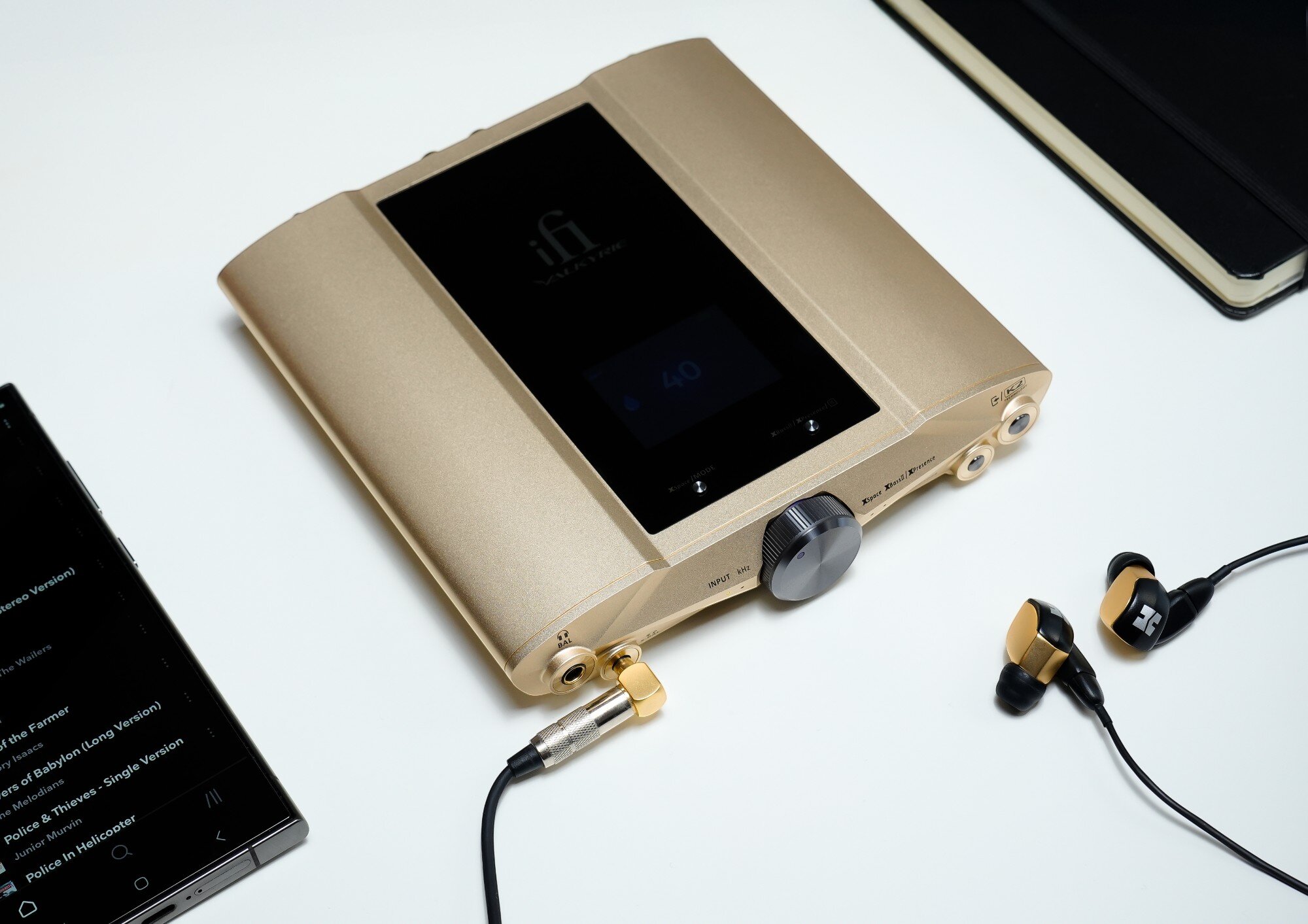
Let’s be honest, most people today with streaming service subscriptions tend to listen to them from their phone using airpods, beats, or some other consumer-level listening device. It gets the job done, but it’s not necessarily doing your music justice.
Recommended Portable USB DACs
The logical next step in your music streaming journey should be to take a look at DAPs if you're interested in keeping your streaming portable. DAP stands for Portable Audio Player and are essentially like iPods on steroids. They're made with premium components, high-end DACs, amplifier circuits, and can handle hi-res local and streaming files and formats with ease. More power, better sound, and having a device solely designated to making your music sound the best it can result in huge gains in fidelity over your smartphone. DAPs can range a lot in price as well, and they can range from around $500 for an older or less powerful model to $3,000 and up. Some of the best brands that we recommend are Astell&Kern, iBasso, and Sony. It’s not just about what they can play, but also how they are designed that makes a DAP outperform a phone or consumer device when it comes to music playback. DAPs by design are typically quite similar to phones, which makes sense because they’re touch screen devices and pretty much every consumer handheld device on the market is designed this way. Rectangular, touch screen, ports, buttons and knobs - it’s in no way a foreign device in itself. It’s designed to be intuitive.
Here’s what you’ll find on most DAPs: a touch screen interface, a built-in headphone amplifier with a selection of ports for your headphones, local and expandable storage options - like a micro SD card, and the real star of the music show - the high-end DAC, or digital-to-analog converter chip or chips. DACs do the heavy lifting of converting your data to an analog signal. Your phone and computer have DACs in them too - basically every consumer device out there that plays music or sound and has speakers has a DAC chip. The only thing is that these factory chips aren’t great and essentially just get the job done. DAPs have high end DAC chips that efficiently and accurately convert your music data to sound the very best it can - oftentimes with the help of the amplifier circuit and other high-end, audiophile-grade components inside the player.
The great thing about digital audio players is that they can handle high-resolution audio streams with efficiency. Playing hi-res files on your iPhone with some Airpods is quite frankly ridiculous because the technology of those Apple products will not yield quality results for high-resolution audio. They do however work in much the same way as a smartphone, so likewise, you'll need to download your streaming apps (or in some cases, they come preinstalled) and press play. An audiophile-quality DAP paired with a nicer pair of headphones will provide a better listening experience all around. DAPs can also act as an access point for an external library. For example, Astell&Kern DAPs have what they call BT Sink - "BT" stands for Bluetooth - and can essentially connect to a device like your phone where you have a music library stored locally, connect via Bluetooth, and stream it through the much better internals of the music player. Why do this? Well, if you don't have the storage space on your DAP or want to supplement your existing library with an external one, then BT Sink is a great option to give you access to even more music. In the end, DAPs are a great first step in upgrading your music from your phone. It's time to get your music back to a standalone playback device like an iPod, just something a little (okay, a LOT) better than your phone.
Getting a DAP, or even just using a portable USB DAC, is taking the next step to better sound, and you can be sure by using one, you’re getting the most out of your streaming experience as well. Take advantage of those higher resolutions and bitrates. If you’re already paying for the high-res service, make sure you’re getting the real high-res listening experience when you’re on-the-go. Next we’ll take a look at desktop streaming options which will give you some more options when it comes to listening to your hi-res music at home.
Desktop Music Streamers
So, let's say that being portable isn't necessarily important to you. Let's check out some music streamers that fit best for desktop scenarios. The best starting point would be the standalone music streamer like the Zen Stream from ifi Audio or the Bluesound Node. These devices are simple to set up, requiring only an app to control the device as well as integrate with your streaming apps all in one place. You can control the device from the app on your smartphone or tablet, or hook it up to a computer via USB and have it stream to your connected Bluetooth device for audio output. It's a great way to get into standalone music streaming with a desktop setup because the streamers themselves are small and affordable, with two great options mentioned here for under $500. Don't be fooled that they're not capable hi-res devices at this price either, because they can easily integrate into much more expensive systems while doing all the heavy lifting of the streaming process directly.
Going a little further and you can get all-in-one units that take on all the roles of your hi-res sound system. All you'll need to do is plug in some speakers or headphones. Typically, these streamers have integrated preamps, amplifier sections, high-end DACs, and high processing power with filters and more to make your streaming music sound the very best it can. Streamers like the Naim Uniti Atom and the Element X2 from Matrix Audio make some of the best all-in-one streaming solutions, with great designs and user experiences. You can set up and access your entire local and streaming music library from one device, and apart from the sheer convenience of doing that, the high-end components in each of these streamers will impress even the most seasoned audiophiles out there. Apart from the noticeable price increase, you'll also have a greater number of inputs and outputs, that in turn increase the compatibility and functionality of the streamer.
You can connect external hard drives with music via USB ports, access network drives via a home NAS system, and use software that integrates your streaming subscriptions with your local music all in one place - there are lots of ways to configure your system depending on where your music comes from. If you have a lot of local storage then a device like a music server or a streamer would be a great option to access your local library remotely. A NAS, or network-attached-storage, works similarly, allowing you to access music files on a hard drive that is configured and connected to your home network. There are even devices like the CD Ripper from Astell&Kern that will take your CDs and rip them directly to your device - DAP or computer - so in theory, you could even set it up to rip your CDs directly to a hard drive which is set up on your home network, allowing you to instantly stream it to your system the moment it's finished ripping. The possibilities are endless.
Recommended Desktop Music Streamers
Verdict
At the end of the day, there are a million and one ways to set up your high-fidelity music streaming system, and the trick is figuring out the best way for your music listening style and what best integrates into your system. Streaming is just a way to get your music from point A to point B, and whether or not you like to stream music from an app or have your music stored locally to stream to a device in your home, there is no right or wrong way to do it. Every music lover's library and ergonomic scenario is different, and so should their music streaming solution. Portable, desktop, NAS, all-in-one device, standalone, streaming apps, external storage - you can configure your system in whatever way makes the best sense to you.
If you have any questions about how to set up your music streaming system or want to get more from your music in general, feel free to Contact Us, and we'll be more than happy to help create a custom music streaming solution for you!

